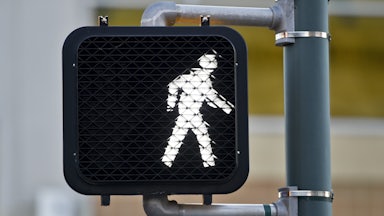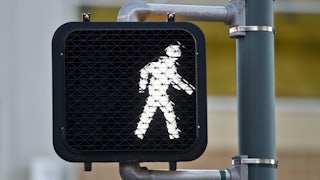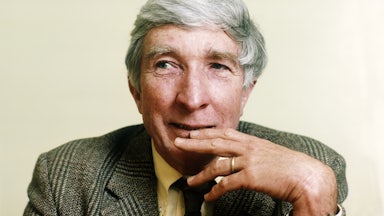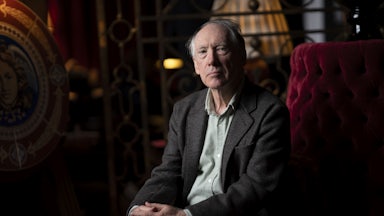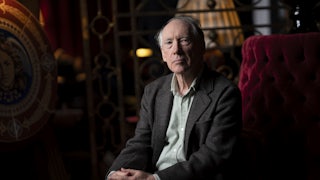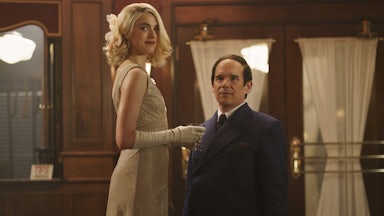Since Donald Trump retook office on January 20, he’s weaponized the federal government to execute his war on “woke,” targeting diversity, equity, and inclusion programs, LGBTQ+ rights, and higher education—all in the name of restoring America’s status as a global superpower. Many of his administration’s actions are unprecedented, but the threats and intimidation surrounding them are not: Bullying, conspiratorial thinking, and legal overreach were similarly on full display in Washington in the years immediately following World War II.
They’re also part of the story told in Clay Risen’s Red Scare: Blacklists, McCarthyism, and the Making of Modern America, which argues that the Cold War–era campaigns to purge the United States of those with suspect Communist leanings—the most visible led by Wisconsin Senator Joseph R. McCarthy, who in the early 1950s claimed he had a list of names of subversives in the State Department—were not just a reaction to fears of a Soviet expansion but also a response to the change wrought by Roosevelt’s New Deal. That expansive political, economic, and social agenda forever altered how the U.S. government addressed the well-being of its citizens—as well as how the government was perceived by those same citizens.
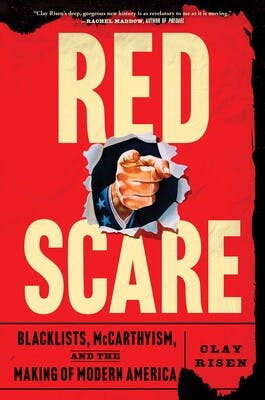
Many of the New Deal’s hallmark programs and projects are still in place today, and helped Roosevelt build a winning electoral coalition. But cultural conservatives interpreted the progressive agenda, according to Risen, as “evidence that something sinister, something foreign, was creeping into the American bloodstream.”
“Starting almost as soon as Roosevelt took office in 1933,” Risen writes, “this impression that the New Deal was being run by an East Coast elite fed into attacks on the administration as not just un-American, but as a tool of Soviet subversion.”
Though Red Scare was completed over a year ago and does not engage in speculation about a second Trump term, there certainly seems to be a through line from McCarthyism—with its purging the federal workforce of “enemies from within,” its interrogating what is taught in classrooms and by whom, and its breaching of civil liberties—to the Trump administration’s assaults on freedom of speech and the rule of law.
I recently spoke with Risen about the conspiracy thinking behind the Red Scare—and the political conditions in which it reemerges—and what can be learned by looking back at a perilous time in American history. Our conversation has been edited for length and clarity.
Marin Scotten: The Red Scare has historically been framed as a reaction to the Cold War, but you write that much of the anti-Communist sentiment of the time stemmed from resistance to the New Deal. What sort of friction did the New Deal create that helped spur this attack on the American left?
Clay Risen: In the 1930s, there was obviously a period of a lot of social, cultural, and economic tumult with the Great Depression going on, but also deeper changes. America was still absorbing a large immigrant population that came in the late nineteenth century, so there was not just this tumult, and not just this explosion of government activism on the part of the Roosevelt administration, but also a wide swath of the American public who took up this banner and said, “OK, this is the new America that we’re building.” I mean, there really was a sense that America was on the verge of collapse as a country. And so the project—obviously the New Deal took this up—but the project that other people saw in more broad terms was: Let’s build something better. Let’s build a better America, right? Let’s build one that has labor rights at the cornerstone. Let’s build one that has more “small-d” democracy, and one that is—and this is really important—fundamentally opposed to fascism.
But obviously, not everyone agreed with this. There was a lot of America that opposed the New Deal for economic reasons but also for cultural and political reasons. They pined for an America that wasn’t that long in the past. What did America look like in the ’20s? Set aside the Jazz Age image from the cities; it was a very conservative place. It was much more of the America that you see in the stories of the Scopes Monkey Trial—much more conservative, much more patriarchal, much more Protestant Christian. Obviously, white supremacy was the name of the game. And there was not nearly the countervailing force that we saw emerge in the ’30s, so these two things stood at odds. Around [the New Deal] was a deeper conflict, and often one that on the right birthed deeper conspiracy theories and allegations—that this is anti-American, and that Roosevelt and his cohort are sneaking communism into America.
The kind of strictures and emergencies of the Cold War suddenly validated everything that people had said in the ’30s and gave room for these conspiracy theories and wild accusations to grow and blossom and really take over a lot of the discourse in America.
M.S.: Do you think the conspiracy that fueled the Red Scare ever really dissipated?
C.R.: Conspiracy theories are nothing new in America. But what happened in the ’30s was a signal change, because there emerged this conspiracy theory that located the enemy within the federal government, so that the critique was no longer that the federal government is too big or unconstitutional or inefficient, but [that it is] fundamentally anti-American. And not just anti-American in concept, but the actors within the federal government are consciously, programmatically going after American society.
That’s sort of the core of this critique. This pops up throughout the Red Scare, and I think never really went away. Today, that’s the “deep state” conspiracy theory. People didn’t have that term back then, but it matches up very clearly. It’s not just any group of people in the administration, but it is liberal, leftist, radical elites who are beholden to foreign ideologies. Then it was communism; today it’s whatever wokeism is. It’s hard to look at where we are today and not see it as yet another outgrowth or another florescence of that same idea.
M.S.: Do you think there are certain consistent cultural circumstances that lead to the strengthening of that idea?
C.R.: My analysis is a little more political than cultural. Because this is fundamentally a conservative phenomenon, right? When the Republican establishment weakens, then this very powerful far-right, or hard-right—because it’s not just the neo-Nazis, or the ultimate fringe, it’s bigger than that, even if it waxes and wanes—that has always been sort of off to the side of the Republican Party. When the establishment weakens, it moves in. There have been times when the establishment has very much openly embraced these folks. It can be very tempting to say, “Well, why don’t you come into the tent?” It took a while for Republicans in the main to decide Pat Buchanan was too far to the right. There was a long period in the late ’80s, when they tried to accommodate him. It’s no coincidence that he came around after 12 years of Republican rule in the White House. [An adviser to a series of Republican presidents, Buchanan ran for the Republican presidential nomination in 1992 and 1996 on a strongly anti-immigration, protectionist, and isolationist platform.] Here’s this guy with new ideas, new energy, and there’s that opportunity.
Every time is different, right? What happened with Buchanan is very different from what happened with Trump. I think what happened with Trump is unique because he essentially took over the party, but he did so at a time when it was very weak.
M.S.: You write that Joe McCarthy, whose name defines this era in American history, is remembered as “an aberration, a wild man, a singular cause of America’s temporary national hysteria. But he was, in fact, a symptom of the era, not its cause.” What role did the media play in sensationalizing McCarthy?
C.R.: McCarthy was, among other things, a master at manipulating print media. He understood how the media worked, and he knew how to use it to his advantage. There were a lot of reporters who were very self-interested and loved to get the exposure of the front-page byline that McCarthy basically guaranteed. Edward R. Murrow—who was a TV journalist and a courageous one—understood that TV was a fundamentally different thing. By putting McCarthy on TV [Murrow’s show broadcast a half-hour prime-time report on the Wisconsin senator in 1954, followed by a damning editorial by Murrow himself], they would see him as the bully, the slob, the permanent five o’clock shadow—and all of that would change what people thought.… It’s a master class in letting McCarthy hang himself. So the media both played into it and ultimately, I think, was responsible for his dumping.
M.S.: Throughout the Red Scare, there’s this culture of fear that created self-censorship in workplaces, universities, and the media, which we’re also seeing today amid fears of funding cuts, job losses, and deportations. How did people emerge from that?
C.R.: Well, some people were willing to stand up. The blacklisted writers and actors deserve enormous credit for not playing the game. But a lot of people just went along with it. And in my mind—and this goes beyond the scope of the book, and it’s not really part of the argument—but I think it really took generational change. One of the dynamics of the ’60s is the boomer generation coming along, being activated by the Civil Rights Movement and the Vietnam War, turning on their parents and basically saying, “How could you let this happen?” And of course, the reason, for a lot of people, is simply they had been browbeaten or told that dissent was bad. It’s one of the great upsides of that [boomer] generation, that they did stand up. And one of the outcomes of the Red Scare was a very vibrant civil liberties community in the United States, and an understanding that civil liberties were fundamental and could not be traded away during times of inconvenience, or self-declared emergencies.
M.S.: You finished this book over a year ago, and you make it very clear that you didn’t write it to draw parallels between past and present. What has it been like to watch much of what you’d been researching so deeply be replicated today?
C.R.: It’s frightening. It’s eerie. Despite what lawyers are doing right now—I do think we have a very strong civil liberties community still, and those people are standing up. On the other hand, the Red Scare was always constrained by a White House that, whether it was Eisenhower or Truman, would only go so far. Today, it’s like the Red Scare is in the house, literally. Someone called it the other day, “the blue scare.” I won’t take credit for that, but I will use it. That’s exactly what’s going on, and you see that in Trump’s rhetoric: He will never just say “the Democrats.” It’s “radical Democrats,” “anti-American Democrats.” That is demonization, exactly like we saw in the Red Scare. Naïvely, I’d like to say the Red Scare ended and so our current moment will end. But I’m not sure what that looks like because, again, the differences are so pronounced.

